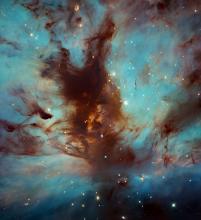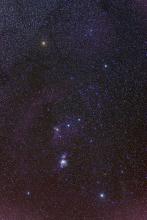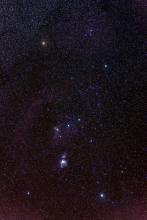Listen to today's episode of StarDate on the web the same day it airs in high-quality streaming audio without any extra ads or announcements. Choose a $8 one-month pass, or listen every day for a year for just $30.
You are here
Orion Rising
An old friend is rising into view in the early morning sky, as it does every year at this time. It’s so bright that it’s easy to spot even through the light of the bright Moon.
Orion the hunter climbs into good view in the eastern sky by about 4:30 or 5. Look for its “belt” of three stars. They form a short line that points up from the horizon.
The belt is surrounded by a tilted box of four stars. Bright orange Betelgeuse is at one corner of the box, to the left of the belt. Blue-white Rigel is at the opposite corner of the box, to the right of the belt.
Like all the stars in the night sky, those of Orion rise about four minutes earlier each night. Orion pops into good view in the morning sky in late July and early August, and rises earlier day by day. By November, it’ll rise before midnight. And by Christmas, the hunter will be in view all night.
The change is caused by Earth’s motion around the Sun. It takes our planet 23 hours and 56 minutes to make one turn relative to the background of stars. In other words, if you look at a specific star, it’ll appear in the same spot in the sky every 23 hours and 56 minutes.
But it takes an extra four minutes for the Sun to return to the same spot in the sky. So our viewing angle on the background stars moves a bit as a result. That causes the stars to rise and set four minutes earlier each day — allowing them to slowly drift through the seasons.
Script by Damond Benningfield






